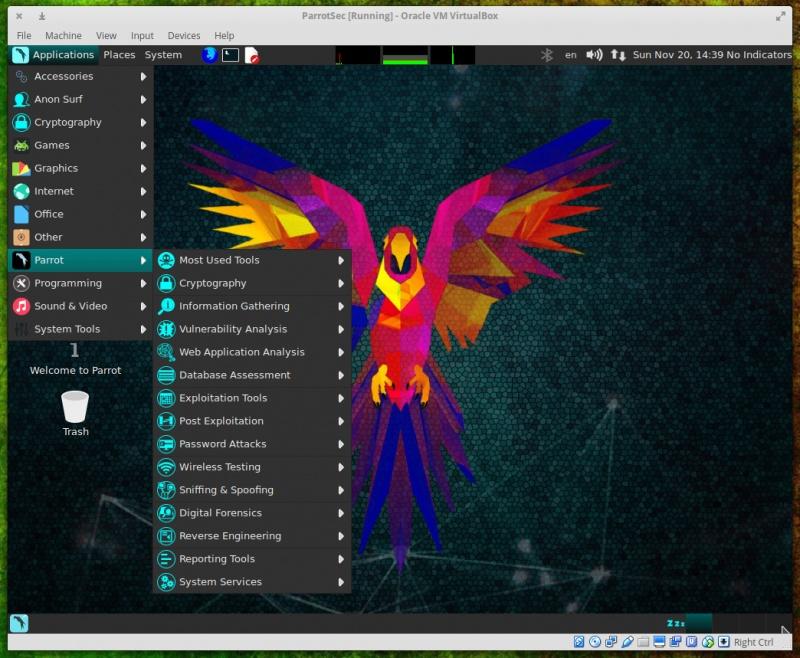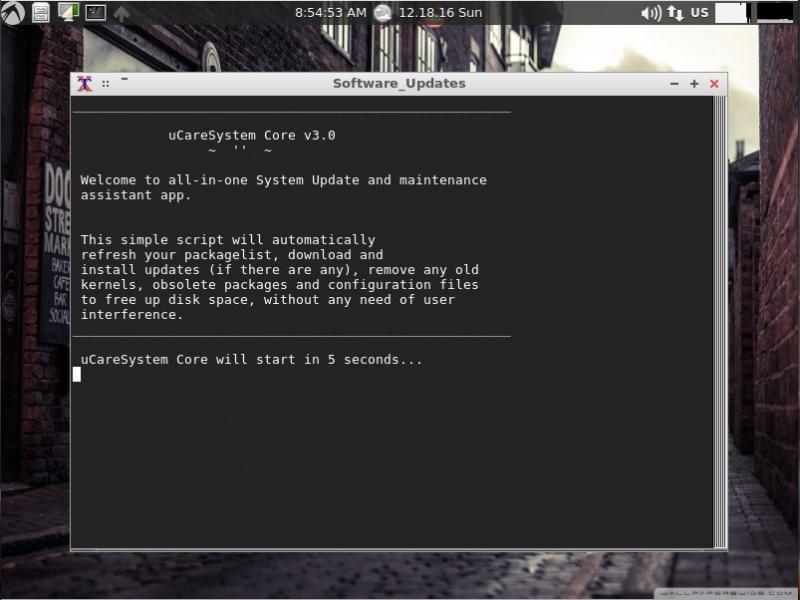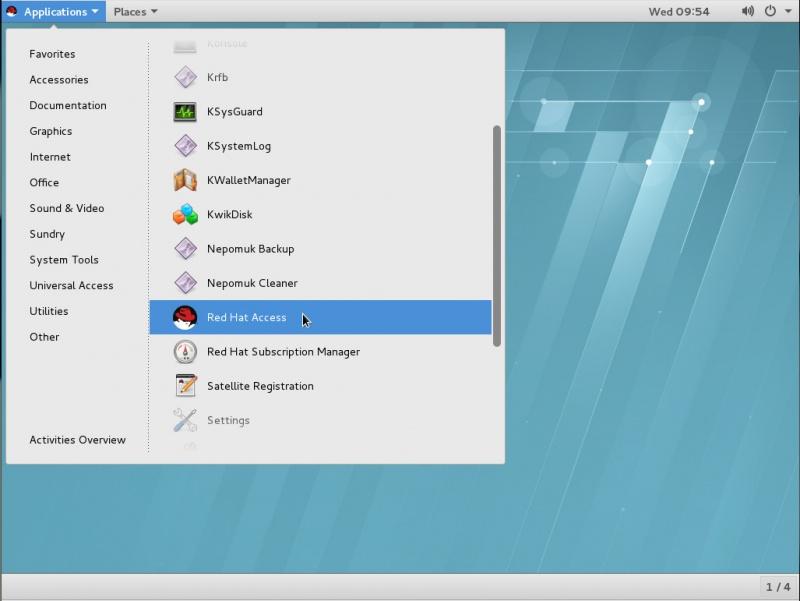Linux-2017: the most promising distributions
The new year has come, which means it's time to look into the future, find the best, most promising Linux distributions.

Linux distributions are often task specific. Therefore, it will not be possible to simply make a list of operating systems and say: “they are the best”. Here, several areas of using Linux are highlighted and those distributions selected that have every chance to become the first in their niche in 2017.

Parrot Linux is based on Debian and offers almost every imaginable means for testing penetration systems.
')
Any administrator is always full of work. Without a good set of tools, his days are a constant test of strength, a continuous race. However, there are many Linux distributions ready to come to the rescue. One of them is Parrot Linux . I am sure he will gain serious popularity in 2017.
This distribution is based on Debian, it offers a huge amount of tools to test the security of systems from unauthorized access. Here, in addition, you can find tools from the field of cryptography and computer forensics, tools for working with cloud services and packages to ensure anonymity. There is something here for developers, and even programs for organizing time. All this (in fact, there is a sea of tools) works on the basis of a stable, time-tested system. The result is a distribution that is great for information security professionals and network administrators.
Now Parrot Linux occupies the 57th position in the Distrowatch ranking. I believe that by the end of the year it will be possible to observe a significant promotion of this distribution to the top of the rating.
Here you can read more about Parrot Linux.

LXLE is a great combination of modest resource requirements and great features.
Without a doubt, LXLE will become a lightweight distribution, which in 2017 will be chosen by many. Why? Because everything in it is very simple. LXLE combines decent features and modest system requirements. In other words, it is a distribution kit that takes up little space, but allows you to fully work on a computer.
In LXLE you can find everything you need, typical of Linux releases for desktop PCs. The system is quite suitable for the home; not the newest computers will be able to work under its management (not to mention quite relevant systems).
LXLE is based on Ubuntu 16.04 (as a result, long-term technical support is provided), the LXDE desktop manager is used here, which, for more than ten years of its existence, is familiar to many, and it is easy to build.
After installing LXDE, you will have many standard tools at hand, such as LibreOffice and Gimp. The only thing you have to do is install a modern browser yourself.
LXLE is currently ranked 16th on the Distrowatch list. All indications are that by the middle of the year, she may well enter the top ten. Read more about LXLE here .

Cute appearance is not the only advantage of Elementary OS Loki. This OS is stable, convenient, its creators are attentive to details.
Maybe I’m biased about this distribution, but I’m sure Elementary OS Loki will do the impossible and drop Linux Mint from first place, having received in 2017 the enviable title of “best desktop distribution”. If so, Elementary OS will accomplish a very impressive feat, given that Linux Mint constantly wins the Distrowatch ranking.
Now Elementary OS is in sixth place (and Linux Mint continues to reign on the first). Is it possible that Elementary OS can overthrow Mint from the throne? It looks like yes. Loki has not only established itself as one of the most beautiful Linux distributions, this system is also stable, convenient, and understandable.
It may seem to someone that the Elementary OS desktop is too much like a Mac. However, such a comparison is a plus of the system, since it speaks of the potential user experience. Of course, the setting of the appearance of Loki is not as limited as the OS X tincture, so you can do exactly what you need from it.
Here is my material on Elementary OS.

Gentoo requires some skill from the user, however, the efforts of those who choose this distribution will be rewarded: they will get exactly what they need.
This category of distros is suitable for anyone who wants to show off their knowledge of Linux. Such operating systems are designed for someone who understands Linux better than others, and is looking for a distribution kit that can be sharply customized for their own needs. When they expect this from Linux, only Gentoo comes to mind.
Gentoo is a Linux distribution based on compiling packages from source codes for specific hardware. After installing the OS, the user is required to self-assemble everything he needs. This not only requires a sufficiently high level of understanding of Linux, but also patience and time. In the end, however, you can get exactly what you need, and nothing more. Gentoo is not a new project, it has existed for many years. But if, among other things, you want to prove yourself and others that you are a connoisseur of Linux, you cannot do without Gentoo.

Through the use of snap-packages, Snappy Ubuntu Core simplifies software installation and eliminates headaches during updates. As a result, we have an OS that is perfectly suited for IoT
Now we are talking about devices of small form factors. The Internet of Things, or IoT, is an area in which the embedded Linux OS simply has no equal. There are many distributions that are suitable for IoT. However, I am sure that 2017 will be the year of Snappy Ubuntu Core .
Using snap packages, installing and updating software in Snappy Ubuntu Core is quick and easy. No need to worry about dependencies or interruptions due to updates.
As a result, we have the ideal software platform for IoT. Ubuntu Snappy Core can already be found in boards for computer enthusiasts (like Rasberry Pi), and also in Erle-Copter drones and Dell Edge Gateways, in Nextcloud Box and in LimeSDR.

CentOS is a reliable server platform.
There is nothing surprising in the fact that CentOS remains a welcome guest on servers of small and medium-sized organizations. There is one very important reason for this state of affairs: CentOS is based on the source code of Red Hat Enterprise Linux (RHEL). Because of this, choosing CentOS, you can be sure that you have a reliable, proven server platform.
The main difference between RHEL and CentOS (besides various marketing strategies) is support. RHEL users are provided with official Red Hat tech support. However, since 2004, CentOS "tech support" is a huge community of enthusiasts.
As a result, if you are a small or medium business owner who is going to transfer his servers to an open source platform, you should first look at CentOS.

Red Hat perfectly meets the needs of corporate clients.
Again, we can say that there is nothing surprising. For example, SUSE is making significant efforts to capture the corporate OS market, one day these efforts will lead it to heights of glory, but something like this will happen, unfortunately, not this year. In 2017, Red Hat Enterprise Linux (RHEL) will hold the first position among the most popular corporate distributions.
According to Gartner , RHEL owns 67% of the market for Linux distributions for large organizations, while a subscription to RHEL brings Red Hat about 75% of revenues. There are many reasons for this state of affairs. For example, Red Hat offers corporate customers exactly what they need, but, besides that, the company makes enormous efforts to develop many open source projects.
Red Hat knows what Linux is and what the corporate sector is. Red Hat trusts quite a few Fortune 500 companies (for example, ING, Sprint, Bayer Business Services, Atos, Amadeus, Etrade). Distribution RHEL brought many developers to a new level in the areas of security, integration, management, in the field of work with cloud systems.
I think, in addition, Red Hat this year will invest a lot of strength in the field of IoT. Although, I wouldn’t be surprised if by the end of 2017 SUSE will bite off a bit more from the market share of Red Hat.
One of the most remarkable aspects of the Linux platform is that, ultimately, the choice is up to the user. You can choose from hundreds of systems, many of which will perfectly meet the most sophisticated requirements. However, if you use one of the above distributions, I am sure he will not disappoint you.
What do you use and why? What can you recommend from the Linux world to our readers?

Linux distributions are often task specific. Therefore, it will not be possible to simply make a list of operating systems and say: “they are the best”. Here, several areas of using Linux are highlighted and those distributions selected that have every chance to become the first in their niche in 2017.
Best distribution for system administrators: Parrot Linux

Parrot Linux is based on Debian and offers almost every imaginable means for testing penetration systems.
')
Any administrator is always full of work. Without a good set of tools, his days are a constant test of strength, a continuous race. However, there are many Linux distributions ready to come to the rescue. One of them is Parrot Linux . I am sure he will gain serious popularity in 2017.
This distribution is based on Debian, it offers a huge amount of tools to test the security of systems from unauthorized access. Here, in addition, you can find tools from the field of cryptography and computer forensics, tools for working with cloud services and packages to ensure anonymity. There is something here for developers, and even programs for organizing time. All this (in fact, there is a sea of tools) works on the basis of a stable, time-tested system. The result is a distribution that is great for information security professionals and network administrators.
Now Parrot Linux occupies the 57th position in the Distrowatch ranking. I believe that by the end of the year it will be possible to observe a significant promotion of this distribution to the top of the rating.
Here you can read more about Parrot Linux.
Best lightweight distribution: LXLE

LXLE is a great combination of modest resource requirements and great features.
Without a doubt, LXLE will become a lightweight distribution, which in 2017 will be chosen by many. Why? Because everything in it is very simple. LXLE combines decent features and modest system requirements. In other words, it is a distribution kit that takes up little space, but allows you to fully work on a computer.
In LXLE you can find everything you need, typical of Linux releases for desktop PCs. The system is quite suitable for the home; not the newest computers will be able to work under its management (not to mention quite relevant systems).
LXLE is based on Ubuntu 16.04 (as a result, long-term technical support is provided), the LXDE desktop manager is used here, which, for more than ten years of its existence, is familiar to many, and it is easy to build.
After installing LXDE, you will have many standard tools at hand, such as LibreOffice and Gimp. The only thing you have to do is install a modern browser yourself.
LXLE is currently ranked 16th on the Distrowatch list. All indications are that by the middle of the year, she may well enter the top ten. Read more about LXLE here .
Best desktop distribution: Elementary OS

Cute appearance is not the only advantage of Elementary OS Loki. This OS is stable, convenient, its creators are attentive to details.
Maybe I’m biased about this distribution, but I’m sure Elementary OS Loki will do the impossible and drop Linux Mint from first place, having received in 2017 the enviable title of “best desktop distribution”. If so, Elementary OS will accomplish a very impressive feat, given that Linux Mint constantly wins the Distrowatch ranking.
Now Elementary OS is in sixth place (and Linux Mint continues to reign on the first). Is it possible that Elementary OS can overthrow Mint from the throne? It looks like yes. Loki has not only established itself as one of the most beautiful Linux distributions, this system is also stable, convenient, and understandable.
It may seem to someone that the Elementary OS desktop is too much like a Mac. However, such a comparison is a plus of the system, since it speaks of the potential user experience. Of course, the setting of the appearance of Loki is not as limited as the OS X tincture, so you can do exactly what you need from it.
Here is my material on Elementary OS.
The best distribution for those who know what's what: Gentoo

Gentoo requires some skill from the user, however, the efforts of those who choose this distribution will be rewarded: they will get exactly what they need.
This category of distros is suitable for anyone who wants to show off their knowledge of Linux. Such operating systems are designed for someone who understands Linux better than others, and is looking for a distribution kit that can be sharply customized for their own needs. When they expect this from Linux, only Gentoo comes to mind.
Gentoo is a Linux distribution based on compiling packages from source codes for specific hardware. After installing the OS, the user is required to self-assemble everything he needs. This not only requires a sufficiently high level of understanding of Linux, but also patience and time. In the end, however, you can get exactly what you need, and nothing more. Gentoo is not a new project, it has existed for many years. But if, among other things, you want to prove yourself and others that you are a connoisseur of Linux, you cannot do without Gentoo.
Best distribution for the Internet of things: Snappy Ubuntu Core

Through the use of snap-packages, Snappy Ubuntu Core simplifies software installation and eliminates headaches during updates. As a result, we have an OS that is perfectly suited for IoT
Now we are talking about devices of small form factors. The Internet of Things, or IoT, is an area in which the embedded Linux OS simply has no equal. There are many distributions that are suitable for IoT. However, I am sure that 2017 will be the year of Snappy Ubuntu Core .
Using snap packages, installing and updating software in Snappy Ubuntu Core is quick and easy. No need to worry about dependencies or interruptions due to updates.
As a result, we have the ideal software platform for IoT. Ubuntu Snappy Core can already be found in boards for computer enthusiasts (like Rasberry Pi), and also in Erle-Copter drones and Dell Edge Gateways, in Nextcloud Box and in LimeSDR.
The best server distribution for small and medium-sized organizations: CentOS

CentOS is a reliable server platform.
There is nothing surprising in the fact that CentOS remains a welcome guest on servers of small and medium-sized organizations. There is one very important reason for this state of affairs: CentOS is based on the source code of Red Hat Enterprise Linux (RHEL). Because of this, choosing CentOS, you can be sure that you have a reliable, proven server platform.
The main difference between RHEL and CentOS (besides various marketing strategies) is support. RHEL users are provided with official Red Hat tech support. However, since 2004, CentOS "tech support" is a huge community of enthusiasts.
As a result, if you are a small or medium business owner who is going to transfer his servers to an open source platform, you should first look at CentOS.
Best Corporate Server Distribution: RHEL

Red Hat perfectly meets the needs of corporate clients.
Again, we can say that there is nothing surprising. For example, SUSE is making significant efforts to capture the corporate OS market, one day these efforts will lead it to heights of glory, but something like this will happen, unfortunately, not this year. In 2017, Red Hat Enterprise Linux (RHEL) will hold the first position among the most popular corporate distributions.
According to Gartner , RHEL owns 67% of the market for Linux distributions for large organizations, while a subscription to RHEL brings Red Hat about 75% of revenues. There are many reasons for this state of affairs. For example, Red Hat offers corporate customers exactly what they need, but, besides that, the company makes enormous efforts to develop many open source projects.
Red Hat knows what Linux is and what the corporate sector is. Red Hat trusts quite a few Fortune 500 companies (for example, ING, Sprint, Bayer Business Services, Atos, Amadeus, Etrade). Distribution RHEL brought many developers to a new level in the areas of security, integration, management, in the field of work with cloud systems.
I think, in addition, Red Hat this year will invest a lot of strength in the field of IoT. Although, I wouldn’t be surprised if by the end of 2017 SUSE will bite off a bit more from the market share of Red Hat.
The choice is yours
One of the most remarkable aspects of the Linux platform is that, ultimately, the choice is up to the user. You can choose from hundreds of systems, many of which will perfectly meet the most sophisticated requirements. However, if you use one of the above distributions, I am sure he will not disappoint you.
What do you use and why? What can you recommend from the Linux world to our readers?
Source: https://habr.com/ru/post/320002/
All Articles